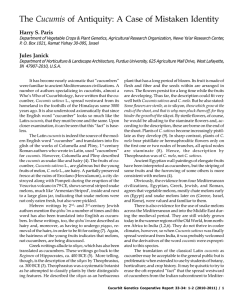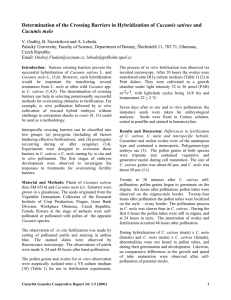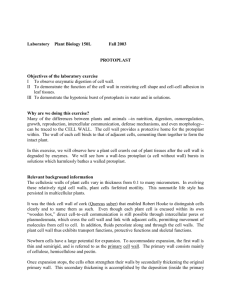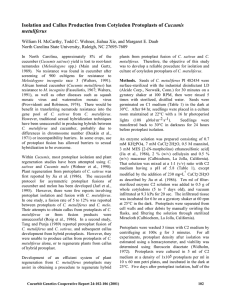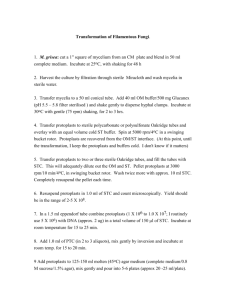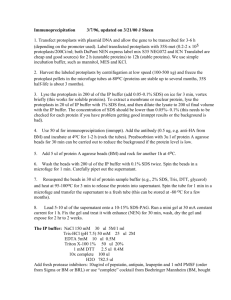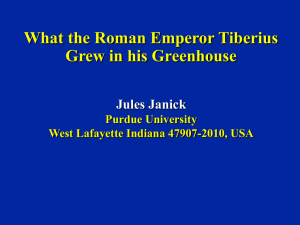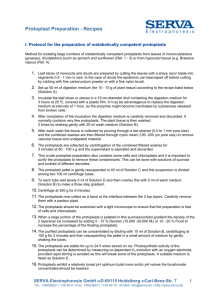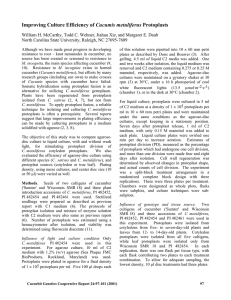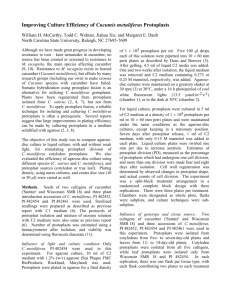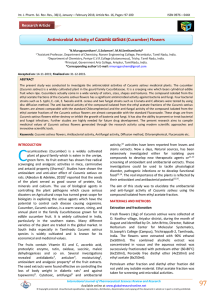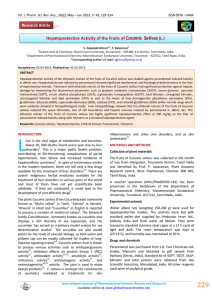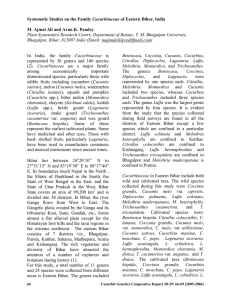Cucumis
advertisement
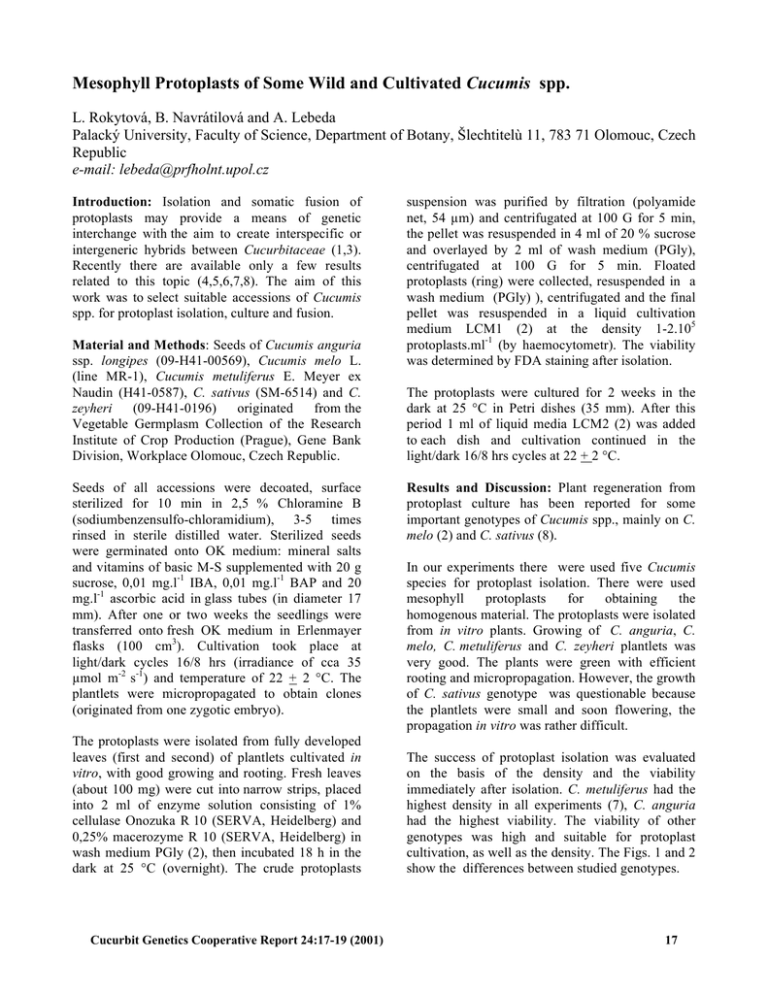
Mesophyll Protoplasts of Some Wild and Cultivated Cucumis spp. L. Rokytová, B. Navrátilová and A. Lebeda Palacký University, Faculty of Science, Department of Botany, Šlechtitelù 11, 783 71 Olomouc, Czech Republic e-mail: lebeda@prfholnt.upol.cz Introduction: Isolation and somatic fusion of protoplasts may provide a means of genetic interchange with the aim to create interspecific or intergeneric hybrids between Cucurbitaceae (1,3). Recently there are available only a few results related to this topic (4,5,6,7,8). The aim of this work was to select suitable accessions of Cucumis spp. for protoplast isolation, culture and fusion. Material and Methods: Seeds of Cucumis anguria ssp. longipes (09-H41-00569), Cucumis melo L. (line MR-1), Cucumis metuliferus E. Meyer ex Naudin (H41-0587), C. sativus (SM-6514) and C. zeyheri (09-H41-0196) originated from the Vegetable Germplasm Collection of the Research Institute of Crop Production (Prague), Gene Bank Division, Workplace Olomouc, Czech Republic. Seeds of all accessions were decoated, surface sterilized for 10 min in 2,5 % Chloramine B (sodiumbenzensulfo-chloramidium), 3-5 times rinsed in sterile distilled water. Sterilized seeds were germinated onto OK medium: mineral salts and vitamins of basic M-S supplemented with 20 g sucrose, 0,01 mg.l-1 IBA, 0,01 mg.l-1 BAP and 20 mg.l-1 ascorbic acid in glass tubes (in diameter 17 mm). After one or two weeks the seedlings were transferred onto fresh OK medium in Erlenmayer flasks (100 cm3). Cultivation took place at light/dark cycles 16/8 hrs (irradiance of cca 35 µmol m-2 s-1) and temperature of 22 + 2 °C. The plantlets were micropropagated to obtain clones (originated from one zygotic embryo). The protoplasts were isolated from fully developed leaves (first and second) of plantlets cultivated in vitro, with good growing and rooting. Fresh leaves (about 100 mg) were cut into narrow strips, placed into 2 ml of enzyme solution consisting of 1% cellulase Onozuka R 10 (SERVA, Heidelberg) and 0,25% macerozyme R 10 (SERVA, Heidelberg) in wash medium PGly (2), then incubated 18 h in the dark at 25 °C (overnight). The crude protoplasts Cucurbit Genetics Cooperative Report 24:17-19 (2001) suspension was purified by filtration (polyamide net, 54 µm) and centrifugated at 100 G for 5 min, the pellet was resuspended in 4 ml of 20 % sucrose and overlayed by 2 ml of wash medium (PGly), centrifugated at 100 G for 5 min. Floated protoplasts (ring) were collected, resuspended in a wash medium (PGly) ), centrifugated and the final pellet was resuspended in a liquid cultivation medium LCM1 (2) at the density 1-2.105 protoplasts.ml-1 (by haemocytometr). The viability was determined by FDA staining after isolation. The protoplasts were cultured for 2 weeks in the dark at 25 °C in Petri dishes (35 mm). After this period 1 ml of liquid media LCM2 (2) was added to each dish and cultivation continued in the light/dark 16/8 hrs cycles at 22 + 2 °C. Results and Discussion: Plant regeneration from protoplast culture has been reported for some important genotypes of Cucumis spp., mainly on C. melo (2) and C. sativus (8). In our experiments there were used five Cucumis species for protoplast isolation. There were used mesophyll protoplasts for obtaining the homogenous material. The protoplasts were isolated from in vitro plants. Growing of C. anguria, C. melo, C. metuliferus and C. zeyheri plantlets was very good. The plants were green with efficient rooting and micropropagation. However, the growth of C. sativus genotype was questionable because the plantlets were small and soon flowering, the propagation in vitro was rather difficult. The success of protoplast isolation was evaluated on the basis of the density and the viability immediately after isolation. C. metuliferus had the highest density in all experiments (7), C. anguria had the highest viability. The viability of other genotypes was high and suitable for protoplast cultivation, as well as the density. The Figs. 1 and 2 show the differences between studied genotypes. 17 Figure 1. The viability of Cucumis spp. Figure 2. The density of Cucumis spp. Cucurbit Genetics Cooperative Report 24:17-19 (2001) 18 The protoplasts of C. sativus and C. zeyheri were more damaged and plasmolysed after isolation in comparison with C. anguria, C. metuliferus and C. melo. The viability of protoplasts decreased on 50 % during 24 hrs of culture. Changes in the form and fragmentation of all studied genotypes were recorded in the culture period 24-48 hrs. The first division in culture was observed from seven to ten days after isolation and viable protoplasts after two weeks. Then the division was stopped and there were no obtained microcalli, calli and plantlets. Protoplast culture of C. anguria was without the division, although the highest viability and good density of protoplast. In general, the best genotype (from the studied set) for protoplast isolation was C. metuliferus because of its easy mipropropagation, high density and viability of protoplasts after isolation. C. melo, C. zeyheri and C. anguria can be used too, but the optimalisation of culture conditions is necessary. Finally, for successfull regeneration of plants from protoplasts there is the most important to find the best genotype. Literature Cited 1. Dabauza, M., L. González-Candelas, M. Bordas, L.A. Roig, D. Ramón and V. Moreno. 1998. Regeneration and characterisation of Cucumis melo L. (+) Cucumis anguria L. var. longipes (Hook. fil.) Meeuse somatic hybrids. Plant Cell, Tissue and Organ Culture 52, 123-131. 2. Debeaujon, I., Branchard, M. 1992. Induction of somatic embryogenesis and caulogenesis from cotyledons and leaf protoplast-derived Cucurbit Genetics Cooperative Report 24:17-19 (2001) colonies of melon (Cucumis melo L.). Plant Cell Reports 12, 37-40. 3. Fellner, M., Lebeda, A. 1998. Callus induction and protoplast isolation from tissues of Cucumis sativus L. and C. melo L. seedlings. Biologia Plantarum 41, 11-24. 4. Lebeda, A., Křístková, E., Kubaláková, M. 1996. Interspecific hybridization of Cucumis sativus x Cucumis melo as a potential way to transfer resistance to Pseudoperonospora cubensis. In: Gómez-Guillamón, M.L., Soria, C., Cuartero, J., Torés, J.A., FernándezMunoz, R. (eds): Cucurbits Towards 2000. Proceedings of the VIth Eucarpia Meeting on Cucurbit Genetics and Breeding, May 28-30, 1996, Málaga (Spain), 31-37. 5. Moreno, V., Zubeldia, L., Roig, L.A. 1984. A method for obtaining callus cultures from mesophyll protoplasts of melon (Cucumis melo L.). Plant Science Letters 34, 195-201. 6. Navrátilová, B., Nisini, P.T., Crino, P., Lucretti, S. 1998. Somatic hybridization between Cucurbitaceae species: Cucumis melo, Cucumis metuliferus and Benincasa hispida. 8th Days of Plant Physiology, 710.7.1998, Olomouc (Czech Republic), Book of Abstracts, 161-162. 7. Navrátilová, B., Rokytová, L., Lebeda, A. 2000. Isolation of mesophyll protoplasts of Cucumis spp. and Cucurbita spp. Acta Horticulturae 510, 425-431. 8. Punja, Z.K., Tang, F.A., Sarmento, G.C. 1990. Isolation, culture and plantlet regeneration from cotyledon and mesophyll protoplasts of two pickling cucumber (Cucumis sativus L.) genotypes. Plant Cell Reports 9, 61-64. 19
